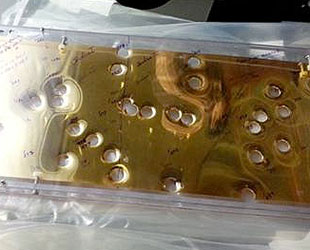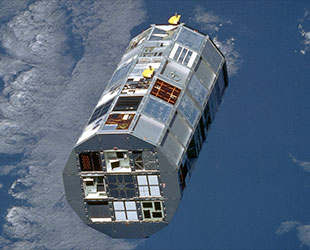Jan. 14, 2015 – A government surplus auction is selling a NASA space artifact that may be worth its weight in gold.
That's because it is gold.
"One lot consisting six 24KT gold plates weighing 6,015.5 grams," the General Services Administration (GSA) listed on its auction site. "These plates were reportedly flown in space for 69 months."
As of Wednesday (Jan. 14), the gold plates had attracted six bids totaling more than $150,000. The auction ends in eight days on Jan. 22.
The GSA listing does not provide many more details about the plates. They are currently the only lot listed under the website's "Shuttle/Hubble" category and originate from the Johnson Space Center in Houston. The GSA auction site offers surplus property from many federal agencies, NASA included.

According to the GSA listing, "these [gold] plates were reportedly flown in space for 69 months." (GSA) |
The "69 months" however, may be a clue as to the plates' spaceflight history.
That specific length of time matches exactly how long the Long Duration Exposure Facility (LDEF) orbited the Earth. The school-bus-sized cylindrical satellite circled the planet from 1984 to 1990, collecting data on the long-term effects of space exposure on different types of materials.
According to NASA, the information learned from the Long Duration Exposure Facility continues to inform spacecraft design to this day.
Launched on space shuttle Challenger's STS-41C mission on April 6, 1984, LDEF was originally meant to spend less than a year in space. Schedule slips and then the loss of Challenger in January 1986 delayed the satellite's retrieval for 5.7 years.
Ultimately, LDEF was returned to Earth by space shuttle Columbia's STS-32 crew on Jan. 12, 1990 — 25 years ago this week.
LDEF's exterior panels did include gold plates. Mounted on the satellite's trailing edge, the high-purity gold was part of the Chemistry of Micrometeoroids Experiment designed to capture cosmic dust residue and orbital debris particles in hypervelocity impacts. After 69 months in space, the gold plates returned with 199 craters.

NASA's Long Duration Exposure Facility (LDEF) in 1984. (NASA) |
According to a summary of the experiment, the plates on the facility measured 20 by 57 centimeters and were about 0.05 centimeters thick. Those dimensions can be used to calculate the volume and, knowing the density of 24 karat gold, the weight of each plate is derived to be about 1,100 grams, or 6,600 grams for six.
The General Service Administration's photos of the plates show that they are riddled with holes, which could account for their lower mass. The holes may be where researchers extracted the craters for post-flight analysis.
Even if NASA were to confirm the plates were from LDEF, their value as an artifact is not likely to greatly affect their sale price. For comparison, tomato seeds that were flown in space onboard LDEF for the same 69 months sell today on eBay for $50 to $100 per package.
At $150,000, the plates may still be a steal. At the current value of gold, the plates are worth about $240,000 for their metal content alone.
